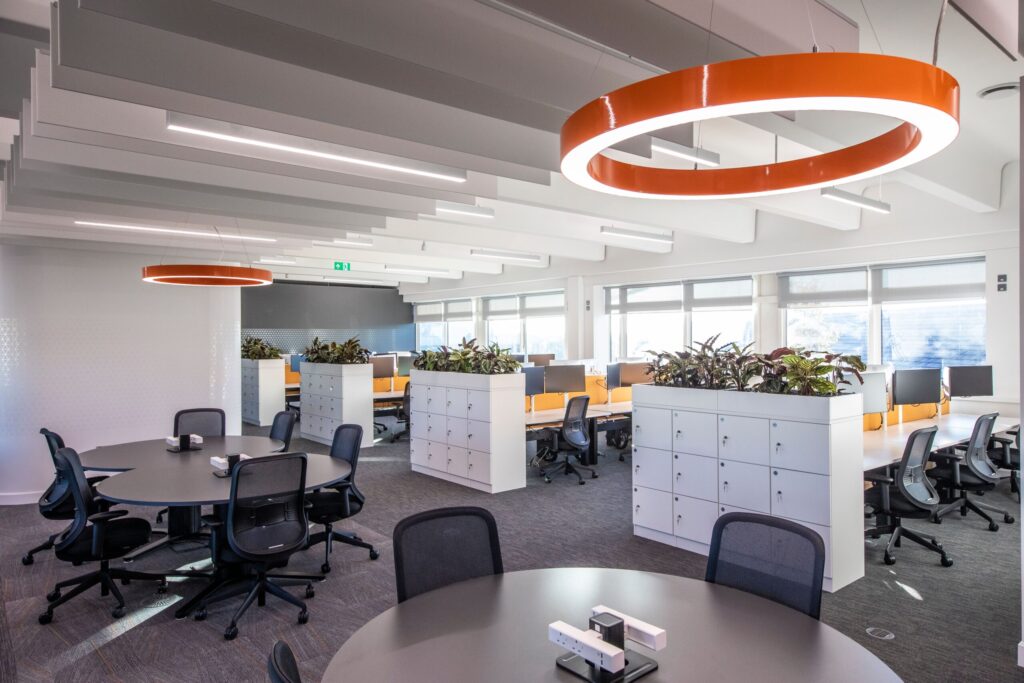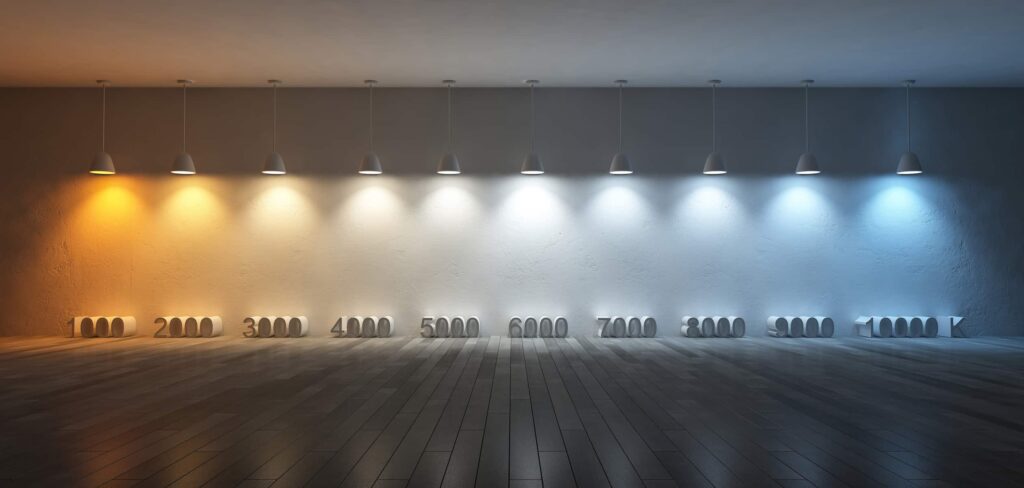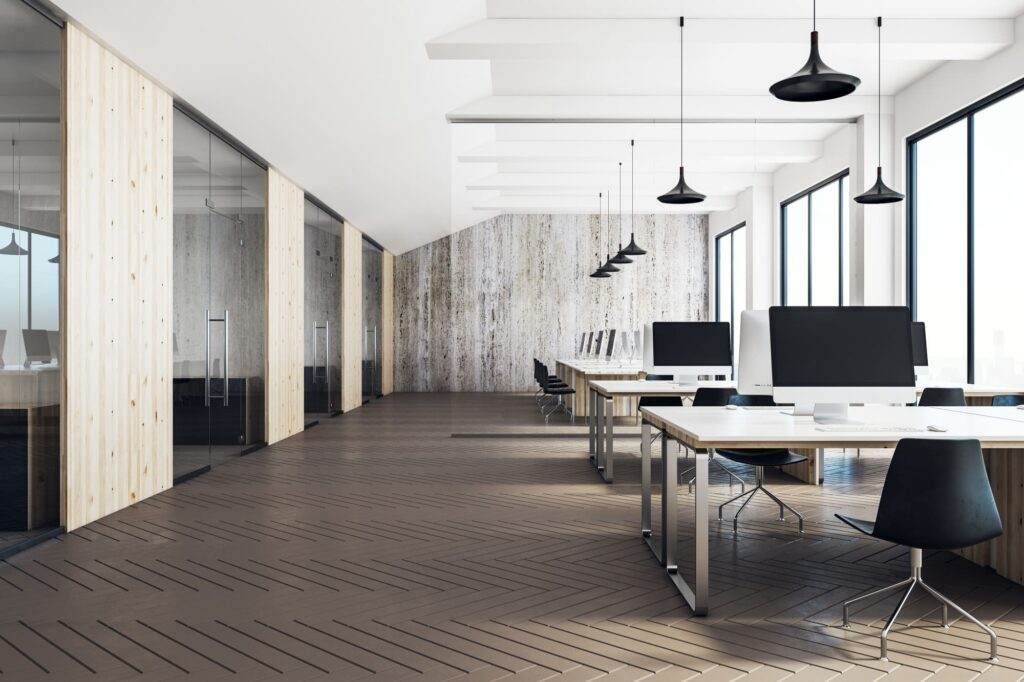LED Office Lighting: Identifying the Ideal Color Temperature
Table of Contents
An invigorating ambiance is crucial for any office environment. To achieve this, a color temperature within the 4000K – 5500K range is generally effective. Nevertheless, different sections of the office necessitate distinct lighting needs. For instance, a warmer temperature suits the office’s break room, while a colder light hue better suits the working area. Moreover, a color temperature under 4000K may lead to drowsiness among office workers. This underscores the importance of precisely understanding color temperature in illuminating offices.
Each individual has their own preferred lighting conditions for work. Some may favor a snug ambiance, while others prefer a more official meeting atmosphere. However, not every light color provides the same level of work comfort. That’s why it’s essential to have a solid understanding of color temperature when it comes to office lighting.
But don’t worry. This article will serve as a comprehensive guide to your office lighting. Let’s delve in.

Is Warm or Cool light better for offices?
Our recommendation is 4000-4500K CCT or middle of the road. Choosing the right color temperature of the light in each area of your office building is essential. Depending on the purpose of the space, you can create a different vibe and atmosphere with the right lighting.
Understanding Color Temperature
Color temperature, or Correlated Color Temperature (CCT), refers to the perceptible color of light that a light source emits. That is to say, the color of the light is entirely dependent on the color temperature. Measured in kelvin (K), color temperature spans between 2700K and 6500K. At higher kelvin degrees, the light takes on a cool, blueish appearance, while at lower degrees, the light offers warmer shades with a yellowish tint.
So, what kind of color and ambiance would you like to instill in your office? Are you leaning toward a warm hue or a cooler one? No problem; continue reading the following discussion to select the ideal color temperature that aligns with your preferences

Deciphering the Color Temperature Chart
The manifestation of color temperature shifts with the degrees of color temperature. The following section will provide a thorough understanding of the color effects based on CCT ratings-
| Color Temperature | Appearance Of The Light |
| 2700-3300K | Warm |
| 3300-5300K | Cool |
| 6500K | Daylight |
These charts illustrate how each interval corresponds to a unique color spectrum. For example, to achieve a warm, inviting ambiance for your office lighting, consider selecting a range of 2700-3300K. This will produce hues of red, yellow, or orange.
In contrast, a choice around 4000K will shift the color profile to less yellow, embracing bluer shades and opting for a lighting temperature close to 5000K, resulting in a blue-and-white color scheme. Consequently, the 3300-5300K range will bestow a calming, blue-tinged atmosphere onto your office space. However, if your preference leans toward a natural daylight-like illumination, a selection of 6500K is ideal.
For these reasons, a fundamental comprehension of the color temperature chart is crucial to accurately decide the lighting requirements for different areas. Moreover, it enables quick identification of various colors and fosters a comprehensive understanding.
What’s the Ideal Color Temperature for LED Office Lights?
Different sections of an office often require distinct lighting arrangements. Nonetheless, considering the entire office, a color temperature of 4000K is the best for LED lighting. Why is this so?
Light at 4000K falls into the category of neutral color. It doesn’t cause eye strain or headaches, promoting a natural atmosphere conducive to heightened work efficiency. On the other hand, lights with a higher Correlated Color Temperature (CCT) emit a bluish tone, adversely affecting employees and resulting in a less energetic workplace.
Thus, the optimal selection is to opt for light with a white tone. This choice will enhance productivity for both workers and visitors and contribute to a lively work environment. Additionally, the mimicry of natural daylight is enough to maintain alertness throughout the day. Furthermore, you can complement this with other lighting elements like spotlights for decorative purposes.
Suggestions for Color Temperature in Various Office Areas
An office’s lighting color and ambiance should be contingent on its intended function. Here are some recommendations for color temperatures tailored to specific areas of your office lighting:
| Office Lighting Areas | Recommended Color Temperature |
| General office | 4000K |
| Employee Break room | 3300K- 5300K |
| Office corridor | 3000K-4000K |
| Lobby office | 5000K |
Office Workspace
In a typical office environment, a neutral color temperature is often favored. A Color Correlated Temperature (CCT) of 4000K is recommended, offering a natural ambiance to the workspace. However, the warmer or cooler hues can be adjusted according to individual preferences.

Employee Lounge
Most businesses have one or two lounges where employees can unwind. Establishing a comforting lighting arrangement in these spaces is advisable. Opt for an amber-yellow hue or a natural blue-white within the range of 3300K-5300K.
Office Hallways
Office hallways connect multiple work areas or conference rooms that necessitate heightened focus. A CCT range of 3000K to 4000K is optimal to instill a professional atmosphere.
Office Reception Area
The reception area is a hub of office activities, often doubling as a collaboration spot. It’s also a common gathering spot for visitors for meetings or casual chats. A cooler white light with a 5000K color temperature provides an ideal setting for this area.
Color Shades Appropriate for LED Office Lighting
Having grasped the basic understanding of color temperature, it’s time to consider color shades.
Color shade is a critical aspect of color temperature, helping you identify which shade is most effective in which setting. The following section provides an overview of these shades.
Warm White: A warm white effect is achieved at a color temperature of 3000K. This light is typically gentle and relaxing, ideal for areas requiring a formal yet inviting ambiance. For instance, warm white is perfect for an office hallway.
Neutral White: Also referred to as the neutral shade because of its white light and harmonious blend of warm and soft colors, this tone falls in the 4000K color temperature range. A neutral white shade is suitable for your general office lighting.
Cool White: Cool white refers to the color temperature synonymous with “daylight.” This color temperature is perfect for areas where a high level of detail awareness is necessary. For instance, your office’s workspace or reception area might benefit from a natural daylight effect.
What Makes Color Temperature Essential in LED Office Lighting?
Functioning in a rigid office setting can be a daunting task. This challenge can further escalate if the ambiance and lighting arrangement leaves much to be desired. Hence, color temperature becomes a fundamental aspect of office lighting.
Office lighting can significantly transform the overall office aura and offer renewed inspiration to employees. A higher color temperature translates to a cooler, more revitalizing light. Furthermore, color temperature influences how different people perceive the office space. While some may appreciate it, others may find it overwhelmingly discomforting. Office tasks such as reviewing emails or rigorous typing demand substantial concentration. Neutral lighting in such scenarios provides a serene environment, thus boosting employee productivity.
Additionally, the break room should have a more yellowish light setting, given that the warmth of such lights assists in relaxation and stress alleviation.
Key Considerations When Selecting Color Temperature
Choosing the color temperature for your office lighting requires careful deliberation on several factors, which include:
Desired Ambiance: The color temperature profoundly impacts the overall ambiance of your office. For example, warmer settings induce a homely feeling, whereas cooler light tones foster an energizing atmosphere. In an office setting, maintaining an energetic environment is paramount. Therefore, cooler color temperatures become an ideal choice. However, cooler color temperatures can also be optimal in manufacturing environments or places necessitating physical labor. These lighting arrangements deter lethargy and promote focused work.
Interior Highlights: The interior decoration of your office significantly contributes to the aesthetic appeal. Thus, selecting the right light color is crucial for underlining the interiors. A cool color scheme for rooms with white, blue, or silver walls or furniture is recommended. Conversely, warmer lighting options are more suitable for rooms with vibrant colors.
Versatile Applications: Offices comprise various lighting needs. For instance, a welcoming atmosphere is preferred in your office’s reception area, which can be achieved using warmer lighting shades. The same applies to the break room.
Moreover, you can use warm or cool shades for office cabinets. LED strips are excellent in this regard. Plain white or tunable white LED strips are perfect for adorning your office ceiling and cabinets. These strips can also be effectively used in your office’s lobby, break room, or restroom.
Adjustable CCT Goods for User-Friendly Experience
Adjustable CCT goods refer to light fixtures with adjustable color temperature. LED flex strips with tunable capability serve as an excellent solution for office lighting. These strips provide the flexibility to alter the color temperature of the lights, transitioning between warmer and cooler tones. Consequently, you can tailor the lighting atmosphere to your work mode.
Also, consider dim-to-warm LED strips for the lobby’s break room. These can create a warm and adjustable ambiance.
LED Lighting Versus Fluorescent Lighting – Which is Superior?
A large number of consumers prefer LED lighting to fluorescent lighting. The reason is straightforward.
LED lighting is superior in efficiency, brightness, and functionality compared to fluorescent lighting. Moreover, when assessing the longevity of the two lighting types, LEDs outlast their counterparts.
However, on a cost basis, LED lights are pricier than fluorescent lights. But considering their durability and infrequent need for replacement, LEDs emerge as a better choice.
Long-term use of fluorescent lights can negatively impact your health, contributing to increased stress and exacerbated migraines. It can also cause eye strain. Therefore, it is more prudent to choose LED lighting, given the potential health hazards.
Here are some more points to consider:
- Regarding Power Usage: Fluorescent lights require more energy than LED lights to achieve the same brightness level, meaning LEDs are more energy-efficient than fluorescent lights.
- Regarding Quality: When it comes to quality, fluorescent lights can’t outperform LEDs. LEDs are celebrated for their dependability and longevity. They also offer more sophisticated features, making them the winner in the quality comparison.
- Regarding Durability: While fluorescent lights might be cheaper, they have a shorter lifespan than LEDs, which can last years. For instance, MyLikeLed’s LED fixtures have a 3 – 5 year warranty.
- Regarding Color Temperature and Rendering: More advanced than fluorescent lights, LED lights provide a precise color rendering index and adjustable temperature – features lacking in fluorescent lighting.
- Regarding Dimming Capability: Both light types can be dimmed, but dimming LED lighting is much easier than fluorescent lights.
Are Fluorescent Lights Detrimental to Office Workers?
Having delved into the differences, you now have a rudimentary understanding of fluorescent lighting. Despite their budget-friendly nature, which initially attracted employers, fluorescent lights have garnered several complaints from office workers. To answer whether they’re detrimental to office employees, the apparent answer is yes.
Besides making the work more strenuous, fluorescent lights have disadvantages that lower productivity. They’ve been reported to induce high-stress levels and eye complications, making vision difficult. Moreover, constant exposure to fluorescent light strains the eyes, leading to worker fatigue and ill health.
Another downside to these lights is their occasional flicker, which can trigger severe mood swings.
Employees have also complained about headaches and disturbed sleep patterns, especially among those working late shifts and going straight to bed afterward. Despite getting sleep, many workers have reported daytime fatigue and lethargy.
Some claims even suggest that fluorescent lights could cause cancer due to radiation emission, although no compelling evidence supports these claims.
How Does LED Lighting Impact Us?
In workplace environments, LED lights are widely considered optimal. The popularity of LED lighting stems from its ability to emulate natural sunlight, thereby enhancing productivity. The brightness and wavelength of this light can affect a person’s circadian rhythm and influence their mood. Plus, natural blue and white lights stimulate brain activity and boost productivity.
Despite their well-known advantages, LED lights do pose some long-term health risks. For instance, overexposure to blue light can lead to health issues, eventually resulting in sleep disorders like insomnia. One health issue can precipitate others due to poor sleeping habits. However, warm, yellowish light can contribute to sound sleep.
How Lighting Influences Mood, Health, and Productivity in the Office
Recognizing the pervasive biological and psychological impacts of lighting in our living and workspaces underscores the importance of understanding how light influences factors like mood, health, and productivity. The role of lighting in our lives extends beyond visibility, significantly contributing to sleep regulation and various other physiological functions. Therefore, taking control of the light utilization in our day-to-day activities is paramount, as illustrated below:
- Daytime versus Nighttime Lighting: It is acknowledged that our preference leans towards brighter light during daylight hours compared to nighttime. Intense lighting during nighttime can suppress the body’s melatonin production, a hormone crucial for sleep regulation. Consequently, this deficiency can trigger additional health complications.
- Blue Light: Commonly favored in work environments, blue light boosts energy and maintains daytime alertness.
- Red Light: While not commonly used, red light has positively affected our health by increasing melatonin levels.
- Warm Lighting: For locations designated for relaxation and winding down, warm lighting is preferred. Its calming tones provide an ideal atmosphere for unwinding.
- White Light: Often a personal preference, white light is deemed to provide the most flattering light for the complexion.
Conclusion
Having an understanding of color temperature when illuminating your workspace can aid in achieving an optimal environment. This guide can assist you in selecting the most suitable lighting options. If you aim for a smart and standard office appearance, consider MyLikeLed lighting solutions. Our high-quality LED strips provide the ideal lighting solution for your office. Get in touch with MyLikeLed for the ultimate LED office lighting solution!
FAQs
The ideal color temperature for office lighting is typically between 4000K and 5000K. This range provides a bright, neutral white light that helps improve focus, productivity, and reduces eye strain.
Color temperature matters because it affects how energized and alert employees feel. Cooler temperatures (above 4000K) mimic natural daylight, making people more focused and less fatigued during work hours.
You should choose cool LED lights for an office. Cool lights (4000K–5000K) create a clean, professional atmosphere and enhance concentration, unlike warm lights that feel cozy and may cause drowsiness.
Yes, 6000K lighting is generally too bright and harsh for an office. It can cause glare, discomfort, and even headaches. A slightly softer light in the 4000K–5000K range is more comfortable for extended work hours.
Yes, the wrong color temperature can hurt productivity. Lighting that is too warm can make employees feel sleepy, while overly cold lighting can cause eye strain, both leading to decreased efficiency.
If you notice eye strain, frequent headaches, or low energy among employees, your office lighting’s color temperature might need adjusting. A shift to neutral or cool white LED lighting can make a big difference.

Hi, I’m Xylia Xiong, a sales professional with 14 years of experience in the LED strip light industry. I specialize in providing tailored solutions, leveraging my expertise in LED products and the latest industry trends. Known for effective communication and problem-solving, I’m dedicated to helping lighting manufacturers, importers, and distributors achieve their goals.
Let’s work together to create customized solutions that exceed expectations.
Related Posts

The Best LED Strip Lights You Can Buy Right Now

Comparing WS2811 Vs WS2812B: Key Differences


